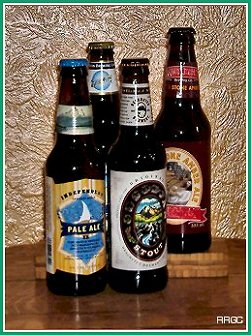Selecting Northwest Beer
In recent years, with the growth of micro breweries and specialty beers, there has been a greater interest in developing guidelines for pairing beer with food. When pairing beer with food, you should drink what you like but also experiment with the many new beers that are now available. and specialty beers, there has been a greater interest in developing guidelines for pairing beer with food. When pairing beer with food, you should drink what you like but also experiment with the many new beers that are now available.
Matching beer with food is similar to pairing wine but it is not as complex or finely honed as it is with wine. To relate beer and wine, think of an ale as a red wine and a lager as a white wine. Beers with a high hop flavor would be the equivalent to pairing food with an acidic wine.
In general, choose beers to compliment the flavors of your food by pairing light meals with light beers and heavy meals with dark beers. You can also select beer that contrasts with the food and this would require some experimentation and the selection would be primarily base on personal preferences. The guidelines for matching beer and food relate to the three main ingredients in beer which are malt, hops and yeast. The following table presents some of the guidelines that are related to beer ingredients:
Beer Pairing Guidelines
Beer Malt
Barley is a grain, similar to wheat, rice or oats but barley is best suited for beer making. The malt contributes flavor, color and body to beer. The flavor is generally sweet, and, depending upon the type of malt used, may be toasty, caramelly, nutty or chocolate-like. Virtually all of the color of beer comes from malt. Some malted barleys are roasted giving additional flavor and color to the beer.
|
Guidelines - Strong malty flavors and sweet beers pair well with spicy dishes as they tone down the spice and bring out the sweetness of the ingredients. Beers with roasted malts pair well with grilled, fried, roasted meats, charbroiled steaks and burgers, and blackened chicken or pork. Meats such as pork or chicken often work best with beers displaying a malt accent.
|
Beer Hops
There are dozens of different hop varieties and each contributes a slightly different character to beer. Hops contribute bitterness, flavor and aroma to beer and act as a natural preservative The flavors and aromas associated with hops include flowery, perfumy, spicy, herbal, resinous, citrusy and grassy characteristics. Many important American hop varieties, including Cascade, Mt. Hood, and Chinook, were developed in the Northwest. Nearly 75% of the nation's hops come from Yakima, followed by smaller amounts from the Willamette Valley in Oregon and the Snake River Valley in Idaho.
|
Guidelines - Beers with hoppy flavors can complement smoked, boiled, steamed or broiled seafood because hoppiness cuts through grease, or anything with acidic ingredient. Hop flavors can enhance the spiciness of highly spiced cuisine. The more hop bitterness the beer has, the heartier or livelier the meal needs to be. American hop flavors and aromas are distinctive and spicy. Hoppy beer styles can deliver bright, zesty flavors of limes, lemon-grass, grapefruit and aromatics that enhance the spice in the dish
|
Beer yeast
There are two main types of beer yeast - ale yeast and lager yeast but many different strains may be found. Each produces slightly different effects in beer and during fermentation the yeast produces alcohol and carbon dioxide. The textural components of beer, its carbonation or residual yeast sediments contribute to beer's flavor. Ale yeast characteristically contribute fruity flavors to the finished beer such as subtle apple, banana, pear and even peach. Lager yeast ferment best at cooler temperatures and during fermentation, the beer acquires a very smooth and pure character. Lagers are very mellow beer and typically lack the fruity features found in ales.
|
Guidelines - Yeast provides itís own flavor and aroma characteristics that are primarily subtle. Yeast flavors in beer can be enjoyed if the beer is matched with delicate foods such as a delicate soup or pasta or light cheeses. These beers also work well with lightly flavored chicken dishes. American wheat beers and German hefeweizens generally have stronger yeast flavors and are great with lighter foods, like salads and seafood.
|

|
|
 and specialty beers, there has been a greater interest in developing guidelines for pairing beer with food. When pairing beer with food, you should drink what you like but also experiment with the many new beers that are now available.
and specialty beers, there has been a greater interest in developing guidelines for pairing beer with food. When pairing beer with food, you should drink what you like but also experiment with the many new beers that are now available.